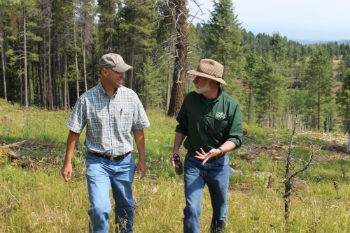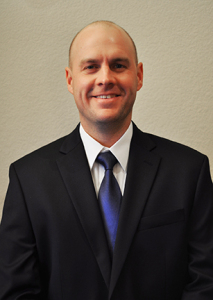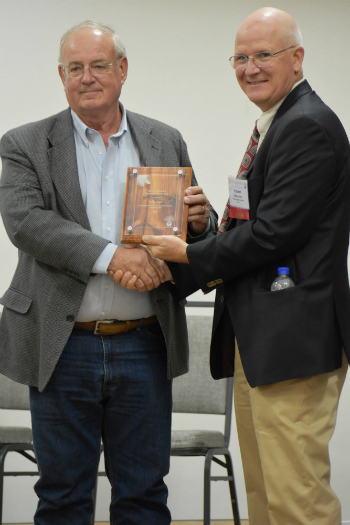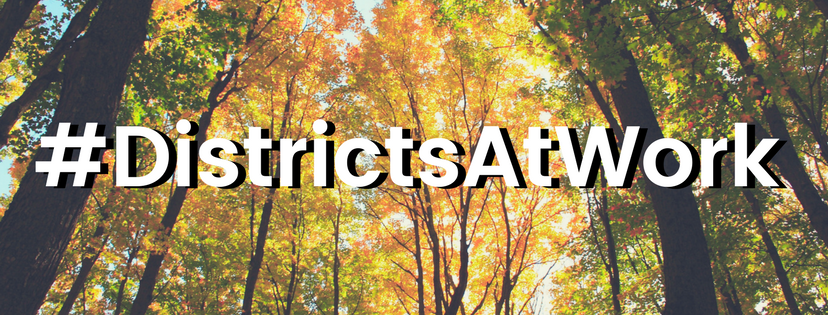DISTRICTS FACILITATE FOREST SUCCESSION PLANNING

More than half of the nation’s forestland is privately owned, but in the coming decades these acres will transition to a new generation of forest landowners, many of whom do not have the same connection with the land that their parents and grandparents have enjoyed. Will they accept the need to manage their woodlands? Will they see the value the forest provides?
According to recent data, “80% of family forest landowners want their land to stay intact, in forest and in family ownership. They have no intention or desire to sell their property.” Yet only a small percentage of families invest the time to talk about how to transfer ownership and maintain forest health for future benefits. This leaves our forests vulnerable to fragmentation and ultimately to a change in land use.
There is important information to pass down: understanding timber tax laws, conservation easement options, the value of having a forest management plan, available cost-share programs, local forestry professionals able to help with management. Perhaps most important, there is a need to share the benefits a forest provides, not only for the family but for the communities and wildlife that rely on it.
Forest succession planning involves a series of steps, often facilitated by a qualified professional armed with resources to address each step in the process. The most important step is the first step: It begins with a conversation.
Read more on NACD's blog about how conservation districts in Oregon, New Hampshire, Michigan, Virginia and Pennsylvania approach succession planning. There, you'll also find a blog entitled "10 Steps to Conservation Planning" to help you and your district create a plan to move forward.
COLORADO PARTNERSHIP WEATHERS OBSTACLES FOR SAKE OF THE FOREST

Colorado’s Upper South Platte Partnership (USPP) is shifting the focus of forest management from counting acres to making acres count. The three-year-old effort in the foothills west of Denver seeks to leverage funding and expertise to implement wildfire mitigation and forest restoration treatments at a landscape scale in critically important watersheds. Read more on NACD's Blog.
FORESTRY NOTES Q&A:
CLINT EVANS

Colorado State Conservationist and Joint Forestry Team 2018 Chair Clint Evans has served as Colorado’s State Conservationist since February 2015. Prior to that, he was the Assistant State Conservationist for Operations in Idaho and spent time working for NRCS in Kansas. This past year, Evans has served as Chairman of the national Joint Forestry Team, which includes representatives from the U.S. Forest Service, NRCS, the National Association of State Foresters and NACD. NACD Forestry Notes sat down with Evans to discuss JFT, the role of districts and the importance of partnership. Read the full interview on NACD's Blog.
COLORADO CONSERVATION DISTRICTS ARE EXPANDING FORESTRY CAPACITY
Conservation districts on Colorado’s Front Range are bolstering forestry programs by increasing the pace and scale of private lands education and on-the-ground practice implementation through ecology-based, multi-resource benefit forestry. Landowner interest is at an all-time high and district foresters are struggling to keep up.
The story of this growth began in 2007 when Jonas Feinstein, now the NRCS State Conservation Forester in Colorado, was working at Jefferson Conservation District under the District Conservation Technician (DCT) program, created through an NRCS and Colorado State Conservation Board grant. “During my time with the conservation district, I saw an opportunity to engage landowners in a novel way by patiently walking, talking, listening, and guiding landowners to understand their forest resource concerns in the context of landscape ecology and land use history, as opposed to a single resource benefit, or an individual tree health approach,” Feinstein said. Read more on NACD's Blog.
DAIGLE RECEIVES AWARD FOR LONGLEAF PINE RESTORATION EFFORTS
 In Nov. 2018, Louisiana Association of Soil and Water Conservation Districts President David Daigle of the Calcasieu Soil and Water Conservation District received the Longleaf Alliance Gjerstad-Johnson Landowner of the Year award. Since 1983, Daigle has been working to restore longleaf pine savannahs, and his work on the properties he owns and operates shows that integrating management systems are advantageous to producers and the habitat. In Nov. 2018, Louisiana Association of Soil and Water Conservation Districts President David Daigle of the Calcasieu Soil and Water Conservation District received the Longleaf Alliance Gjerstad-Johnson Landowner of the Year award. Since 1983, Daigle has been working to restore longleaf pine savannahs, and his work on the properties he owns and operates shows that integrating management systems are advantageous to producers and the habitat.
Before European settlement, longleaf pine savannahs stretched across the southeast United States from the Carolinas to Louisiana, spanning an estimated 92 million acres. Only a fraction of the once vast forest remains. Restoration can be problematic. Brush control, fire regimes and plant diversity all have to be balanced with great effort and expense for the massive natural mechanism to operate. As a cattleman and forest product producer, Daigle has perfected a low-input method for restoring the longleaf pine savannah ecosystem and is making a living doing it. He manages these valuable forest habitats through a simple method of mimicking the natural systems that originally maintained them. Read the full story on NACD's Blog.
|
|
|
|
|
Email Marketing By
|


|
|
|
|
|




 In Nov. 2018, Louisiana Association of Soil and Water Conservation Districts President David Daigle of the Calcasieu Soil and Water Conservation District received the Longleaf Alliance Gjerstad-Johnson Landowner of the Year award. Since 1983, Daigle has been working to restore longleaf pine savannahs, and his work on the properties he owns and operates shows that integrating management systems are advantageous to producers and the habitat.
In Nov. 2018, Louisiana Association of Soil and Water Conservation Districts President David Daigle of the Calcasieu Soil and Water Conservation District received the Longleaf Alliance Gjerstad-Johnson Landowner of the Year award. Since 1983, Daigle has been working to restore longleaf pine savannahs, and his work on the properties he owns and operates shows that integrating management systems are advantageous to producers and the habitat.

